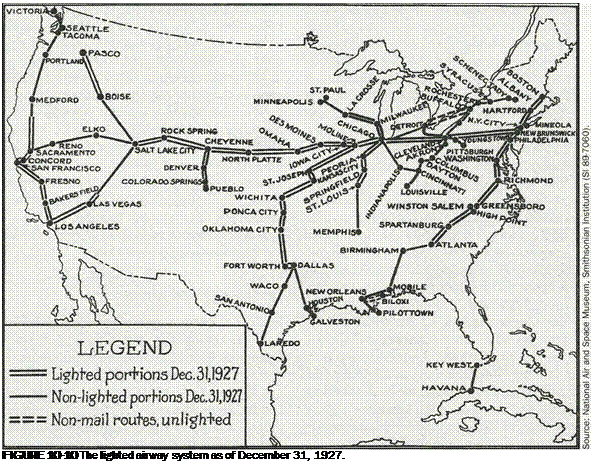The Lighted Airway
In 1923, Congress granted an appropriation to fund the construction of a system of sequential lighting on the transcontinental airmail route. The first segment completed was between Chicago and Cheyenne, a stretch of flat country most conducive to this original effort, and centrally located along the route. Airplanes launched at first light on either coast could reach the lighted segment by nightfall under most circumstances.
Beacons were placed on 50 foot steel towers constructed every 10 miles along what had come to be known as the “airway.” The beacons rotated so as to allow pilots to see their flash from 40 miles away in good weather. If the beacons were located at a landing field, the beacons showed a green course light, if not, then red. Morse code, which is still used as part of the FAA navigation scheme today, was introduced into the airway system at the time of this first construction. Each beacon flashed an identifier in Morse code that corresponded to the number of the beacon within the airway segment.
Regularly scheduled airmail service was begun on July 1, 1924, just over six years from the inauspicious kick-off in Washington, D. C.
with Lt. Boyle. Due to prevailing winds, east – bound mail crossed the nation in 29 hours, while that mail bound for the West took 34 hours. This provided a savings in time of at least two full business days in mail going from coast to coast compared with mail carried by rail. Within the first full year of operation, the lighted airway system had been completed coast to coast. (See Figure 10-10.) American aviation, with the leadership of an enlightened government, had made a quantum leap into a technologically advanced civilian navigation system. Nothing like it existed in the world.
 |
The American scene was almost set for the beginnings of a viable commercial aviation transportation system, but not quite. Still to come
were more reliable engines, sturdier airplane designs, acceptance of flight by reference only to aircraft instruments, involvement of the banking and financial community, acceptance by the public of aviation as legitimate transportation and, lastly, those visionaries and adventurers, both physically and financially, who would make it all happen.










